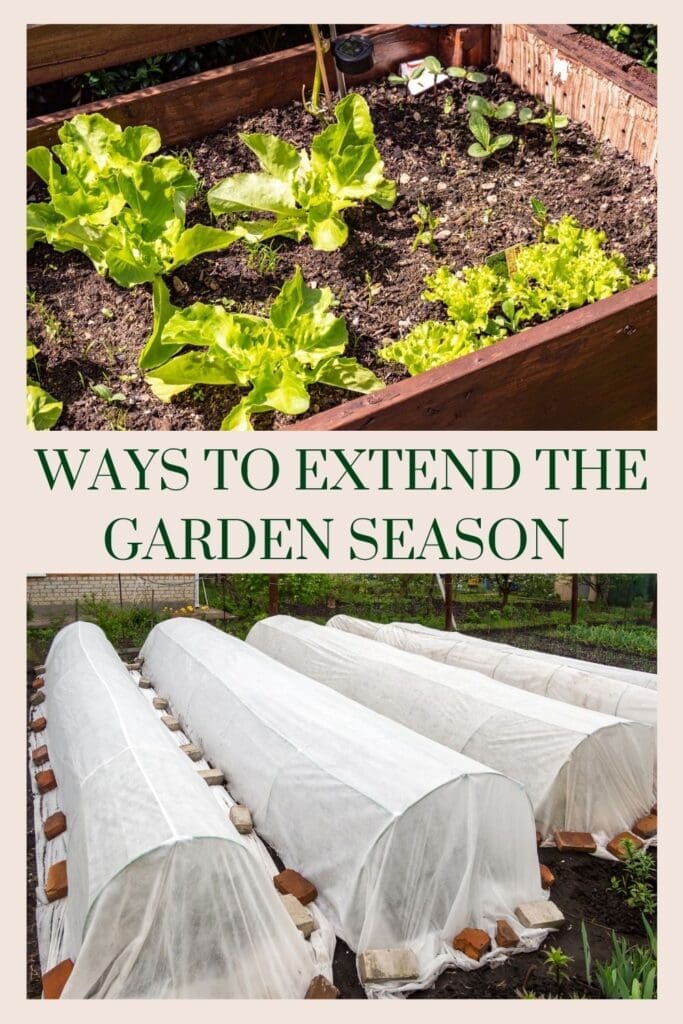Extending the Garden Season into Winter: 11 Easy Ways. As the crisp days of fall set in, many gardeners think the harvest season is over. But with a little planning and the right tools, you can extend your gardening season into winter, even in cold climates like Wisconsin.
We try and extend our vegetable garden as long as we can.
Why Extend Your Garden Season?
For many gardeners, the end of the summer doesn’t mean the end of fresh produce. In fact, I’ve found some of my most rewarding harvests come in the cooler months. When most people have packed up their tools for the season.
Gardening year-round has always been a personal goal of our family. It’s about enjoying homegrown vegetables even during winter and feeling that deep connection to nature all year long.
There are several benefits to extending your garden season. First, you get to enjoy more fresh produce, meaning fewer trips to the grocery store and more savings.
It’s also a great way to maximize the investment you’ve already put into your garden. Why let your hard work go to waste when you can continue to harvest well into the fall and winter?
With just a few techniques, you can turn a short growing season into a bountiful autumn and even winter harvest. This post will guide you through practical and easy ways to extend your gardening season, no matter where you live.

Understanding Frost Dates and Microclimates
Before diving into ways to extend the growing season, it’s important to understand your local frost dates.
The average first frost date is a key factor in determining when to start using season extenders. This date can vary based on your zip code, so it’s important to check your local resources or even your seed packet instructions.
In colder regions like Wisconsin or Northern Illinois, frost can arrive as early as September, but with some thoughtful planning, you can make the most of the warm days and protect your garden when cold nights arrive.
Taking advantage of microclimates within your yard can also help.
Areas near buildings, fences, or other sheltered spots often stay warmer longer, trapping heat during the day and offering protection against strong winds.
Sunny spots that receive plenty of sunlight during the day can help keep soil temperatures warmer, which is perfect for growing cold-tolerant crops like brussels sprouts, swiss chard, and root crops.
Some vegetables are more resistant to frost than others. Crops like leafy greens and root vegetables can withstand light frosts, while hard frosts are best suited for cold-tolerant crops like brussels sprouts and swiss chard.
With the right combination of planting times and season-extending methods, you can stretch your gardening season well beyond the typical cutoff date, making every inch of your garden count.
Ways to Extend the Garden Season into Winter
Whether you’re trying to get an earlier start in early spring or make the most of the late fall, these 11 season-extending techniques will help you grow more vegetables and enjoy fresh produce long after the first frost.
1. Cold Frames: A Garden’s Best Friend
Cold frames are an excellent way to extend the gardening season by trapping heat from the sun. These mini-greenhouses are typically built from old windows or clear plastic and are placed over your vegetable beds. Cold frames keep cold air at bay, raising soil temperatures and protecting young plants from cold nights and frost. Root crops like carrots and swiss chard can thrive inside a cold frame well into winter.
2. High Tunnels and Hoop Houses: Larger Season Extenders
For those with more space, high tunnels and hoop houses are ideal for extending the season. These structures are essentially large, unheated greenhouses made of pvc pipe or metal, covered with plastic sheeting. High tunnels are tall enough to walk inside, while low tunnels are smaller and often cover individual rows of vegetable crops. Both options provide significant frost protection and trap heat, making it possible to grow cool-season crops like brussels sprouts, bok choy, and leafy greens deep into the fall and winter.

3. Row Covers for Frost Protection
A floating row cover is a lightweight fabric that you can drape over your garden plants to protect them from light frosts. Available in various thicknesses, heavier fabrics provide more protection during cold temperatures, while lighter ones allow plant growth and airflow. Row covers are ideal for cool-season plants like lettuce and salad greens, protecting them from strong winds and fluctuating daytime temperatures.
4. Mulching for Winter Warmth
Applying a thick layer of mulch, such as grass clippings, straw, or black plastic mulch, around your plants can insulate the soil and keep root vegetables from freezing. Mulching is a great way to retain soil moisture and trap heat around root crops like beets, parsnips, and turnips. This technique works well in combination with other methods like cold frames or row covers for added protection.
5. Plastic Milk Jugs and Hot Caps
For a quick and easy solution, you can create mini greenhouses using plastic milk jugs or hot caps. Simply cut the bottoms off and place them over single plants to trap warmth and protect from frost. This method works particularly well for smaller plants like swiss chard or young transplants that need a little extra protection from temperature extremes. The greenhouse effect created by the jugs will help plants survive cold nights.
6. Raised Beds for Better Drainage
Growing in raised beds offers several advantages when trying to extend your garden season. These beds warm up faster in the spring and retain heat better in the fall, giving you a longer growing season. Raised beds also improve drainage, which can be particularly important during the winter months when excess moisture can lead to root rot. Cool-weather crops like brussels sprouts, kale, and bok choy perform well in raised beds, especially when combined with other season extenders.

7. Hot Beds for Early Germination
Creating a hot bed is another excellent way to extend your gardening season. By adding a layer of manure beneath the soil, which generates heat as it decomposes, you can raise the soil temperatures around your plants, encouraging seed germination and growth even in cooler weather. Hot beds can be used with cold-tolerant crops like spinach and radishes, allowing you to start growing earlier in the season and keep growing later into early fall.
8. Drip Irrigation to Maintain Soil Moisture
As the cooler temperatures set in, it’s important to manage soil moisture properly. Installing a drip irrigation system ensures your plants get consistent water without soaking the foliage, which can be prone to frost damage in cold weather. Drip irrigation is especially beneficial for extending the harvest of root vegetables and keeping your soil evenly moist during warm days and cold nights.
9. Succession Planting for Continuous Harvest
Succession planting is a great way to maximize your garden season. By staggering your plantings of cool-weather crops like leafy greens, snap beans, and swiss chard, you ensure that new plants are always coming up as older ones mature. This technique is perfect for extending the harvest well into the fall months, giving you plenty of cool-season vegetables to enjoy throughout the winter.
10. Water Walls and Other Heat Traps
Water walls—essentially tubes filled with water that surround plants—are another effective season extension method. The water absorbs heat during the day and releases it at night, protecting plants from cold temperatures. This technique works particularly well for tender crops and can extend the growing season of heat-loving crops like tomatoes and peppers.
11. Unheated Greenhouses for Year-Round Growing
An unheated greenhouse can keep your garden productive through the winter by harnessing the sun’s energy to maintain warmer air temperatures inside. This structure is ideal for protecting long-season crops and extending the harvest of fall vegetables. Adding plastic mulches or garden fabric inside can provide even more insulation during cold weather. With an unheated greenhouse, you can enjoy fresh produce like leafy greens and herbs throughout the winter.

Enjoy Fresh Produce All Year
By using these simple yet effective methods, you can easily extend your gardening season and enjoy a fall harvest of cool-season crops well into the winter months.
Whether you’re protecting your plants from frost with cold frames or creating a warm microclimate with hot caps, there’s a solution for every garden.
Embrace the challenge of winter gardening and make the most of your homegrown vegetables, even in the coldest months.
References
University of Maine. Bulletin #2752, Extending the Gardening Season.
University of Wisconsin Horticulture Division. Extending the Growing Season.
Utah State University. Extending the Garden Season.


